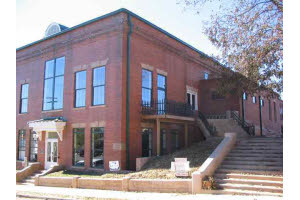- Easley High School Auditorium
Infobox_nrhp2 | name =Easley High School Auditorium
nrhp_type =

caption = Building Restored for Use as Residential Condominiums - 2007
location= 112 Russell Street,Easley, South Carolina
lat_degrees = 34
lat_minutes = 49
lat_seconds = 48
lat_direction = N
long_degrees = 82
long_minutes = 36
long_seconds = 0
long_direction = W
locmapin = South Carolina
area =
built= 1909
architect= Cunningham, Frank H. & Joseph G.; Gallivan Co.
architecture= Renaissance Revival
added = January 21, 1999cite web|url=http://www.nr.nps.gov/ |title=National Register Information System|date=2008-04-15|work=National Register of Historic Places|publisher=National Park Service]
governing_body = Private
refnum=98001646Easley High School Auditorium is a historic building built in 1909 in
Easley, South Carolina and now on theNational Register of Historic Places . It is historically significant for its long association with education and civic life in Easley in the first half of the 20th century. The building served as Easley’s first and only high school from 1909 to 1940 and was central to the early experience and training of almost every local resident of that period.cite web|url=http://www.nationalregister.sc.gov/pickens/S10817739007/index.htm |title=Easley High School Auditorium, Pickens County (112 Russell St., Easley) |accessdate=2008-09-02|work=National Register Properties in South Carolina listing|publisher=South Carolina Department of Archives and History]Architecture
Architecturally, the load bearing masonry building in the
Renaissance Revival style is significant for its early efforts to introduce steel trusses into traditional masonry-bearing wall and heavy timber construction. It has also been noted as an outstanding early example of the work of architects Frank H. and Joseph G. Cunningham. The building illustrates the early use of steel trusses to provide a clear-span auditorium with 18-foot ceilings.citation|title=PDFlink| [http://www.nationalregister.sc.gov/pickens/S10817739007/S10817739007.pdf National Register of Historic Places Registration: Easley High School Auditorium] |32 KB|date=April 29, 1998 |author=Robert W. Bainbridge, Judith Bainbridge, Sandra Scetti and Christopher Knopf |publisher=National Park Service, Section 7, page 5] At the time of construction, use of steel trusses was still in the experimental phase. The design of the building is an early example of “the gradual replacement of load-bearing masonry and heavy timber structures with steel frame construction.”citation|title=PDFlink| [http://www.nationalregister.sc.gov/pickens/S10817739007/S10817739007.pdf National Register of Historic Places Registration: Easley High School Auditorium] |32 KB|date=April 29, 1998 |author=Robert W. Bainbridge, Judith Bainbridge, Sandra Scetti and Christopher Knopf |publisher=National Park Service, Section 8, page 8] The building has 86 tall windows with segmental arches, laid out like those in many textile mills in the region.Later Use
When the building opened in the fall of 1909, its classrooms allowed the seventh through tenth grades to have their own rooms for the first time (an eleventh grade was added in the 1920-21 school year. The school had outgrown the facility by 1938 and a new building was constructed on a different site in 1939-40. Following completion of the new school building, the auditorium was occupied by a shirt manufacturer until 1964.
From that time until its listing on the National Register, the building went through various periods of vacancy and occupation by a local furniture store for limited storage use.
Recent Restoration
The building had fallen into disrepair when the Easley Chamber of Commerce applied for its recognition as one of the most-endangered properties in the state. A period of planning on how to return it to a place of prominence within the community followed. In the early 2000s the building was rehabilitated and restored to private use as residential condominiums.
The building stands at 112 Russell Street and was placed on the
National Register of Historic Places in 1999. The South Carolina Department of Archives and History has additional pictures and information, as well as the NRHP nomination document.References
Wikimedia Foundation. 2010.
